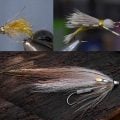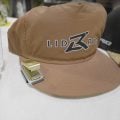How to Tie the Icy Hot Jig
Producer: Tim Flagler
I call this fly the Icy Hot Jig. Over the years, I’ve found that flies with blue in them seem to be very effective during the winter months. And by adding some orange and yellow, I kind of get an egg effect as well. Although we’re just coming into winter now, this fly has shown a lot of promise.
For a hook, a Lightning Strike JF2 jig hook in size 16 is a good choice. I find it easier to handle with plunger-style hackle pliers as opposed to just my fingertips.
I’m going to pair the hook with a 7/64” slotted Tungsten bead in gold. I’ll pick up the bead with my bodkin which will allow me to center the small hole in the fingertips of my left hand. I can then easily insert the point of the hook into that small hole and work the bead around onto the hook shank then up to behind the eye. I’ll next get the whole assembly firmly secured in the jaws of my tying vise.
For thread, I’ve loaded a bobbin with a spool of UTC 70 Denier in fluorescent orange. Get your thread started on the hook shank at the back edge of the bead and take a few wraps rearward before snipping or breaking off the tag.
To help stabilize the bead, I’m going to use .02 lead-free round wire. Simply stuff the end of the wire into the slot of the bead and take thread wraps to secure it. I’m not trying to add weight here, just to stabilize the bead and build up the collar area a bit. End with your tying thread at about the hook point.
White saddle hackle fibers are used for the tail of the fly. Pull down a dozen or so perpendicular to the stem then strip them free. You can align the butts to make sure the tips are aligned. Measure to form a tail a hook shank in length and transfer that measurement rearward to the start of the bend. Snip the butt ends off square then give your bobbin a quick, counterclockwise spin so when you take that first thread wrap it jumps slightly rearward to catch the butt ends. Keep taking thread wraps down the shank to the start of the hook bend then forward to just in front of the hook point.
Sulky Sliver Metallic in a pearl color is used to rib the fly, a 4” length is enough to make several flies. Lay one end of the material against the near side of the hook and take thread wraps to secure it. Bind it down all the way to the start of the bend then return your tying thread to in front of the hook point.
Now comes the fun part. Blue Steelie Ice Dub is used to create the abdomen of the fly. Take an ample clump from the packet. Pull down on your bobbin to expose about 5” of tying thread then begin dubbing a substantial dubbing noodle on your thread. With the noodle established, start taking wraps so the dubbing begins right at the base of the tail. Make sure to get a complete wrap around the hook shank with the dubbing as this is critical for the next step. Double your thread over as if you’re making a dubbing loop but secure the thread to the hook shank just behind the bead. This will allow you to snip the thread, that holds the dubbing noodle, free. Now, using ringed plunger-style hackle pliers, get hold of the dubbing noodle. Make sure the pliers are gripping both the dubbing and the thread, not just the thread. Snip off any excess thread or noodle so it won’t get in the way. Pick up a dubbing whirl, if you have one, and hook it to the ring of the hackle pliers. Pull your bobbin out of the way and give the whole rig a good clockwise spin and marvel at just how tight the dubbing noodle gets. Remove the whirl from the hackle pliers then start making touching wraps with the corded-up noodle to form a slim, slightly segmented abdomen on the fly. When you reach your tying thread, use it to secure the noodle then snip the excess off close. At this point I do like to trim away any really raggedy-looking fibers.
Get hold of the Sulky and begin making open spiral counter wraps with it to rib and segment the fly. Then use your tying thread to secure it behind the bead before snipping the excess off close.
Orange Ice Dub is used for the thorax of the fly. Pull just a small clump free from the packet and with it create a short, slim dubbing noodle on your tying thread. Start taking wraps so the dubbing begins at the front edge of the fly’s blue body. Continue taking wraps to build up a slightly bulbous thorax then bare thread wraps behind the bead to build up an orange hot spot collar. When the orange really starts to stand out, pick up your whip finish tool and do a 4 or 5 turn whip finish, seat the knot well and snip or cut your tying thread free.
For whatever reason, thread collars like this have a tendency to come unraveled. I’ve found a drop of head cement or here Solarez Bone Dry UV cure resin almost mandatory. A healthy shot of UV light will set everything in place.
I can’t wait to give this fly a real thorough testing over the next couple winter months.
How to tie the Icelandic Black Ghost
How to Tie the Infamous Pink Worm











